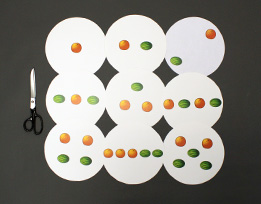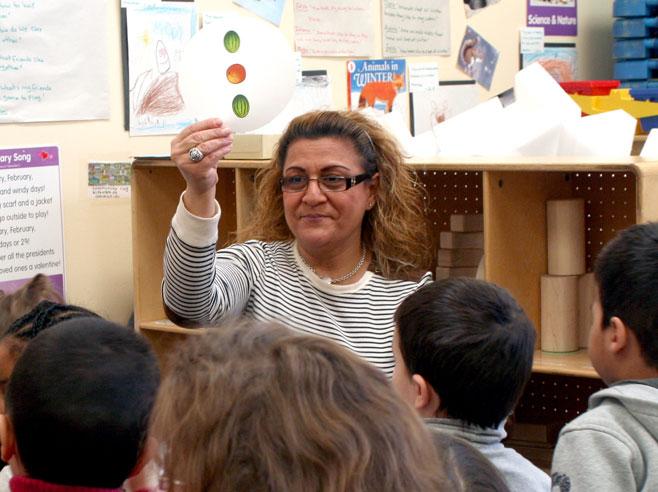Children play a game where they QUICKLY shout out or compare the number of pictures on the plates shown.
Materials

- 9 Picture Plates templates (PDF)
- Cardstock or plain paper
- Scissors
- Optional: 9 white paper plates
- Optional: 13 and 16, respectively, of two types of stickers (3/4" or larger in size, richly colored, in simple shapes such as, apples, oranges, cherries, or non-food items, such as balloons, stars, and diamonds.)
Preparation
- Print the Picture Plates (on cardstock, if possible) and cut them out. For a more authentic experience, make picture plates out of nine paper plates and two types of stickers, using the following instructions.
- To make your own picture plates: This set of picture plates is made using nine white paper plates with two different types of stickers in different arrangements for number sets 1–5. Round plates have the advantage of having no particular orientation, so children can see that a square formation of four stickers becomes a diamond formation of four stickers when turned 45 degrees. Use stickers that have a simple shape, so the children can easily make it out. Place the stickers on nine paper plates in the same arrangement as on the Picture Plates PDF above.
Directions
This activity can be done multiple times over several days. Start with the steps 1-5. Then, as children gain familiarity, extend the activity with steps 6-8.
- Make sure the order of the plates is mixed up. Place the plates in your lap so children can’t see the pictures.
- Hold up a picture plate for two seconds only so children can see the pictures, then quickly place it back in your lap.
- Ask the children to show you how many pictures were on the plate by holding up that number of fingers or saying the number out loud.
- Repeat the activity with the rest of the picture plates.
- After you have displayed several plates, ask them to explain how they know what the number is.
- To extend this activity if you have time or on another day, try the following variation: Flash a picture plate showing the triangular pattern of three dots for two seconds only and ask the children, How many? Then, flash the plate showing a straight line of three dots and again ask, How many?
- Then, hold up the two variations of the number 3. Ask, What’s different? What’s the same? Does the number of pictures change because they are in different places? How do you know that? Can you show me?
- Repeat the activity. This time use the two variations of the numbers 4 and 5.
Note: If the game is too challenging, slow it down and have the children count the pictures on the plates.

